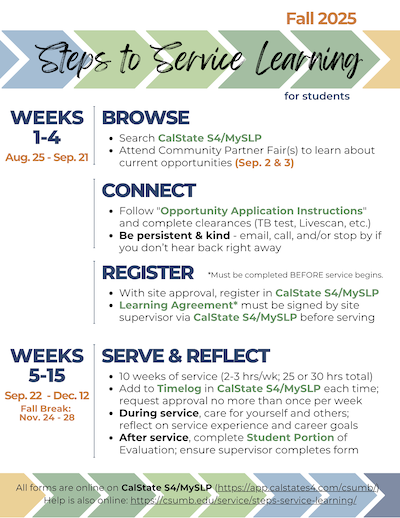Steps to Service Learning
CalState S4
Use the following link to log into our partner database, CalState S4 (also known as MySLP).
Clicking on the link below will cause you to leave the CSUMB website. Links to external sites are provided for informational purposes only and do not constitute an endorsement by the Service Learning Institute or CSUMB of the content, products, services, or viewpoints expressed on those sites.
Use the pages in the left-hand menu to view the details of each step in the process.
1. Browse
In this mode, you are searching for opportunities. You have guidance from your service learning course professor; you have your interests and availability and transportation in mind.
2. Connect
With opportunities and partner sites in mind, armed with your skills, interests, availability, and transportation needs, you follow the “Opportunity Application Instructions” to reach out to partner organizations about their opportunities. You are determining if it’s a good fit for you and waiting to receive the “green light” from the community partner.
3. Register
After completing the two steps above and getting the “green light” from the partner site; you can register your placement in the CalState S4/MySLP system. You will need to start in a very specific place in the system in order to enter the “place” pathway.
4. Serve
While serving, you will represent yourself and CSUMB professionally and positively. You will log your hours in CalState S4/MySLP, communicate any absences or schedule changes with supervisors, and keep everyone’s safety top of mind.
Service Learning Semester Timeline for Students, printable and accessible version.

As you begin your service relationship with a community agency, you are probably eager to get involved and make a difference in the lives of people with whom you'll work and the agencies with which you'll serve. We expect that you will view yourself as a representative of CSUMB in the community. As such, we ask that you carefully read through and abide by the following guidelines created to assist you in having the best and most productive experience possible:
CSU policies
The California State University (CSU) is committed to an inclusive and equitable community that values diversity and fosters mutual respect. All Students and Employees have the right to participate fully in CSU programs, activities, admission, and employment free from Discrimination, Harassment, Sexual Misconduct, Sexual Exploitation, Dating Violence, Domestic Violence, Stalking and Retaliation.
This Nondiscrimination Policy is established in compliance with:
- Title VI and Title VII of the Civil Rights Act of 1964;
- Title IX of the Education Amendments of 1972, Nondiscrimination on the Basis of Sex in Education Programs or Activities Receiving Federal Financial Assistance (34 C.F.R. 106.);
- The California Equity in Higher Education Act;
- The Violence Against Women Reauthorization Act of 2013 (which amends the Jeanne Clery Disclosure of Campus Security and Campus Crimes Statistics Act, commonly known as the Clery Act) (VAWA) under its Campus Sexual Violence Elimination Act provision (Campus SaVE Act);
- Section 504 of the Rehabilitation Act of 1973;
- Title II of the Americans with Disabilities Act of 1990;
- The Age Discrimination Act of 1975; and
- Other applicable state and federal laws which prohibit Discrimination, Harassment, Sexual Misconduct, Sexual Exploitation, Dating Violence, Domestic Violence, Stalking, and Retaliation.
Read more about the CSU policies:
Reminders for service learning students
- Your Learning Agreement must be completed BEFORE you begin your service hours. This requires that you have a conversation with your site supervisor before registering on CalState S4 and before serving.
- Here are some search tips to help you navigate the active opportunities: Opportunities Search Tips.
- In order to register your placement, you need to start in a specific location to enter the “register/place” pathway. See REGISTER for directions.
- Don’t forget to click on the “finish placement” button after completing the Learning Agreement and Release of Liability forms at the end of the registration process. Your site supervisor and faculty will encounter errors when trying to sign your forms if you forget to click that silly button.
- For fingerprints, you are encouraged to make a Livescan (fingerprint) appointment with University Police. University Police will bill the Service Learning Institute directly; no out-of-pocket costs for students!
-
- If you get a livescan (fingerprint) done elsewhere and the hosting organization does not cover the costs, then the Service Learning Institute will reimburse the costs for any service learners. Please follow the Livescan Reimbursement Guidelines.
-
- View the Student-Initiated Service Site process and instructions, if needed.
Virtual Drop-In Sessions
Drop-in sessions are for questions, placement support, and CalState S4/MySLP help.